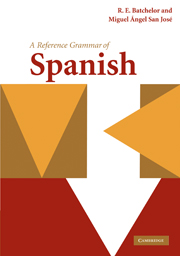Book contents
- Frontmatter
- Contents
- Preface/Prólogo
- Acknowledgments/Agradecimientos
- Abbreviations/Abreviaturas
- Introduction to the Spanish language/Introducción a la lengua española
- Part I
- Part II
- Part III
- Part IV
- Part V
- Part VI
- Part VII
- Part VIII
- Part IX
- Part X
- 76 Names of countries, regions, US states, continents, oceans, rivers, mountains, volcanoes/Nombres de países, regiones, estados de los EE.UU., continentes, océanos, ríos, montañas, volcanes
- 77 Proper names/Nombres propios
- 78 Foreign and indigenous words/Palabras extranjeras e indígenas
- 79 Incorrect use of “la”/“le”/“lo”/Uso incorrecto de “la”/“le”/“lo” (laísmo, leísmo, loísmo)
- 80 Incorrect use of “de” and “que”/Uso incorrecto de “de” y “que” (dequeísmo, queísmo)
- Appendix I Verb tables/ Tablas de verbos
- Appendix II Glossary/Glosario
- Bibliography/Bibliografía
- General index/Índice general
- Subjunctive index/Índice del subjuntivo
79 - Incorrect use of “la”/“le”/“lo”/Uso incorrecto de “la”/“le”/“lo” (laísmo, leísmo, loísmo)
from Part X
Published online by Cambridge University Press: 05 June 2012
- Frontmatter
- Contents
- Preface/Prólogo
- Acknowledgments/Agradecimientos
- Abbreviations/Abreviaturas
- Introduction to the Spanish language/Introducción a la lengua española
- Part I
- Part II
- Part III
- Part IV
- Part V
- Part VI
- Part VII
- Part VIII
- Part IX
- Part X
- 76 Names of countries, regions, US states, continents, oceans, rivers, mountains, volcanoes/Nombres de países, regiones, estados de los EE.UU., continentes, océanos, ríos, montañas, volcanes
- 77 Proper names/Nombres propios
- 78 Foreign and indigenous words/Palabras extranjeras e indígenas
- 79 Incorrect use of “la”/“le”/“lo”/Uso incorrecto de “la”/“le”/“lo” (laísmo, leísmo, loísmo)
- 80 Incorrect use of “de” and “que”/Uso incorrecto de “de” y “que” (dequeísmo, queísmo)
- Appendix I Verb tables/ Tablas de verbos
- Appendix II Glossary/Glosario
- Bibliography/Bibliografía
- General index/Índice general
- Subjunctive index/Índice del subjuntivo
Summary
Incorrect use of third person pronouns
These three nouns point to what are considered “incorrect” uses of the third person pronouns la, le and lo. To a very large extent, but not in every case, their faulty usage resides in confusion over the direct and indirect objects.
Laísmo
Laísmo is the defective use of la(s) as a feminine indirect object, instead of le(s). The pronouns la, las derive from the Latin accusative forms illam, illas. In consequence, la and las function in standard Spanish as direct objects. La/s encontré en la calle. (I met her/them/found it/them in the street.)
Thus, in cultured Spanish, the following sentence: Cuando Juana abrió la puerta, la dije que…, la is not acceptable, any more than Yo la di un beso a Josefina, or A María la duele la cabeza. In all three cases, “correct” Spanish le replaces la, since it corresponds to the dative case or indirect object. This phenomenon of laísmo is only found in Central and Northern Spain, and does not extend to Andalusia, which explains its absence from the Canary Islands and Spanish America. It is viewed with unmitigated condemnation by a consensus of grammarians, both Spanish and Spanish-American, and is therefore not to be imitated.
Laísmo with “se”
Laísmo is also common with the pasiva refleja “se”: A esta chica se la llama María, where one would doubtless prefer: A esta chica se le llama María.
- Type
- Chapter
- Information
- A Reference Grammar of Spanish , pp. 485 - 486Publisher: Cambridge University PressPrint publication year: 2010



